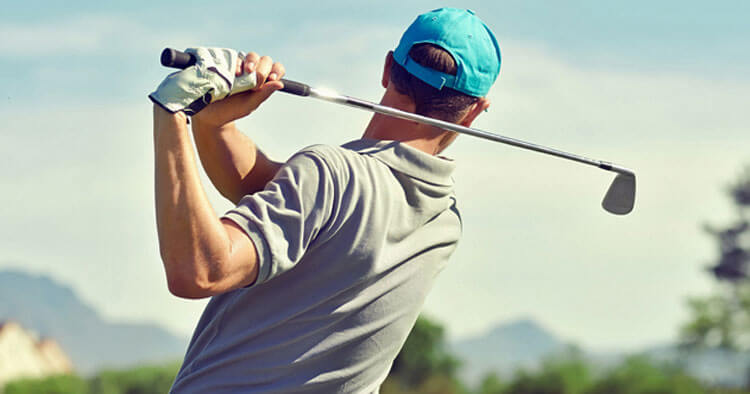Injury Rehabilitation and Training, Muscle Pain and Tendinopathy, Shockwave Therapy, Sports Injuries and Management
Medial Elbow Pain: Treating Golfer’s Elbow
Diagnosing Medial Elbow Pain
Diagnosis of golfer’s elbow is normally a clinical diagnosis made by your physiotherapist, doctor or similarly appropriately skilled practitioner. Following listening to the complaint history and performing a few appropriate clinical tests, your physiotherapist can generally confirm a the diagnosis of Golfer’s Elbow without requiring any diagnostic investigations like X-rays or MRI… However in some situations investigations may be required to help confirm the diagnosis, grade the severity of injury and rule out other causes of pain. In these circumstances a simple ultrasound scan can be useful and coupled with an X-ray of the elbow joint to assess any bony or joint changes these two investigations can provide a lot of useful information to treating practitioners. An MRI gives the most reliable visual of soft tissues changes with performing surgical investigation and an MRI is effective at identifying tendinopathy more accurately than ultrasound imaging but as noted above an MRI is normally unnecessary in assisting the management planning of golfer’s elbow and is likely only to be used if conservative management isn’t progressing as planned, or an exact diagnosis of the cause of medial elbow pain is proving challenging.
Referred Pain And Golfer’s Elbow
It is worth noting that the cervical spine can refer pain into the upper limb and pain on the inside of the elbow, mimicking golfer’s elbow can sometimes be referred from the neck (specifically the lower levels of the neck are capable of referring pain into the elbow area). Therefore it is important to mention to your treating physiotherapist the presence of any neck discomfort you may be concurrently experiencing, regardless of how irrelevant you may feel it is. Local treatment directed at the your elbow will be fruitless if the nature of the pain is that is is being referred from the cervical spine. Often your physiotherapist may even look to assess your neck and nerve mobility of your upper limb regardless of any denial of neck discomfort in an attempt to be thorough and confirm, or exclude any neck dysfunction, or neural tension. Failure to recognise the relevance of the neck in medial elbow pain, may potentially result in slow, or even no improvement of the condition.
Treatment For Golfer’s Elbow As A Cause Of Medial Elbow Pain
The use of physiotherapy in the treatment of golfer’s elbow can be an effective approach to managing the condition and is commonly the first line of treatment for soft tissue complaints at the elbow. Treatment aims to achieve both a reduction in medial elbow pain and restoration of function through facilitating tissue repair, restoring tissue movement and strength both locally and in any associated areas such as the cervical spine and neural tissue as formerly mentioned.
Physiotherapy And Golfer’s Elbow
It is not uncommon for a golfer’s elbows complaint to last anywhere from 6-24 months. Physiotherapy treatment is an effective way of managing golfer’s elbow in the acute and chronic setting. Physiotherapy treatment may be made up of a number of approaches depending on practitioner and the stage and severity of the condition. Possible treatment options can commonly include:
- localised manual therapy,
- activity modification
- strengthening exercises such as eccentric loading exercises
- taping techniques, or bracing support prescription,
- dry needling
- as well as this shockwave therapy has also been shown to be an effective treatment for tendinopathies like golfer’s elbow.
Treatment of associated areas like the cervical spine and neural structures may also be beneficial when treating medial elbow pain. Your physiotherapist will most likely prescribe some home exercises for you to do as well to continue the management of the condition once you leave the practice, these could be made up of stretching, or strengthening loading exercises as well as nerve mobility, or cervical and thoracic mobility and postural exercises. Your physiotherapist may also recommend an elbow support, similarly to treating lateral elbow tendinopathies the use of offloading supports like “tennis elbow straps” are an effective addition to golfer’s elbow management in some individuals. Your physiotherapist can help assess for appropriateness of any bracing options and guide around the desired use in daily life. The function of the these braces are as a counter force brace that works to offload the irritated structures dissipating stressful gripping forces away from injured structures.
Early Physiotherapy Treatment Achieves Better Outcomes
Generally as holds true with most conditions, the sooner you visit your physiotherapist and begin treatment for your medial elbow pain the better. Initiating treatment sooner rather than later means you are more likely you achieve a good result and the quicker you’ll be able to resume your usual activities.
Corticosteroid injections and platelet-rich plasma (PRP) injections are sometimes considered as options for stubborn tennis elbow and golfer’s elbow complaints, however the majority of people get better with the modification, or rest from aggravating activities and physiotherapy treatment.
Disclaimer: Sydney Physio Clinic provides this information as an educational service and is not intended to serve as medical advice. Anyone seeking specific advice or assistance on Treating Golfer’s Elbow should consult his or her general practitioner, physiotherapist or otherwise appropriately skilled practitioner.


